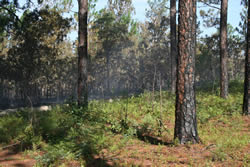
National Fire Plan Success Story
Spring Burning Slows Wildfire
Carolina Sandhills National Wildlife Refuge, South Carolina
National Fire Plan - Fuels Reduction
2009

A wildfire burning along the border of the Carolina Sandhills National Wildlife Refuge runs out of fuel when it bumps the edge of an area where a prescribed burn was conducted a few months ago in South Carolina. Photo Credit: U. S. Fish and Wildlife Service.
On July 29, 2009, a prescribed fire burned five months earlier came to the aid of firefighters on the Carolina Sandhills National Wildlife Refuge when gusty winds pushed a wildfire toward the refuge boundary. The fire, started by an escaped debris burn on private property, was also threatening a nearby home when firefighters first arrived on the scene. Soon after firefighters secured the structure, the fire moved onto refuge lands and bumped into the area that had been burned earlier in the year. When it hit the edge of the prescribed burn area, because the reduction in fuels from the 175-acre prescribed burn lit in March limited the fire spread, firefighters were easily able to contain the incident.
“With the wind and the fuels that are typical to the area, the fire had the potential to be much larger,” said Mark Parker, Refuge Fire Management Officer. The fire was held at the refuge boundary to 6 acres on private lands and less than 0.10 acre on refuge lands in a stand of longleaf pines.
The refuge annually burns approximately 12,000 acres as part of their fire management program to reduce the risk of wildfire to neighboring communities and to maintain healthy habitat for wildlife. The South Carolina refuge offers one of the southeast’s premiere longleaf pine ecosystems and is home to more than 140 groups of the endangered red cockaded woodpecker.